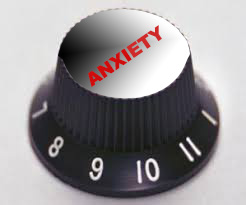
Denise knows how to act in times of crisis. She was quick to decide to close her office, re-think priorities and organize her team to work remotely before sheltering was even ordered. Overall, her leadership created the reassurance needed in the highly uncertain time caused by Covid-19.
However, her internal sound volume of anxiety remained high. It’s been hard not to imagine worst case scenarios about the impact of an economic crisis on her organization and the people it serves. Although she’s been aware of her anxious thoughts -while keeping them private- inevitably they have leaked onto others via her stress reactions: a frantic pace, breakdowns of communication with her team and a constant push for doing more.
A lot of people in leadership positions can relate to these strong waves of anxiety about the future.
I recently read about the concept of unhealthy anticipatory grief in an HBR article/interview (link– probably the most quoted article in the last few weeks – rightly. The sudden and severe changes in our habits due to Covid-19 is bringing extreme discomfort that pertains to the emotion of grief.
Unhealthy anticipatory grief is all about anxiety – what we feel when we imagine the worst-case scenarios in the future. Often, we don’t need a full scenario to feel anxious – diffused glimpses of images are enough. (Watching endless bad news on TV tends to boost my own unhealthy anticipatory grief.)
Imagining the worst-case scenarios in the future, due to the loss of safety in the present, is different than risk-management.
I was talking with another dear client who had worked as a COO a while back, in a global non-profit where she did a lot of risk-management. When she watched what was happening in China this February, she immediately knew that we would soon be sheltering in the US too, and she would probably be stuck in her small house. She bought cleaning products to disinfest the house, plenty of toilet paper, and food supplies for one month. Her family thought she was crazy, but she did what she had to do and was ready when the sheltering order arrived. She was practicing good risk management.
Unlike risk management, Unhealthy anticipatory grief is a mental habit that might give us a strange sense of control and protection, but it only perpetrates the feelings of deep malaise and insecurity. It can be debilitating and it doesn’t accomplish anything constructive.

There are lots of strategies to lower the volume of anxiety and calm down the mind, that include:
– Unpacking the wave of anxiety with a trustful partner. Talking through the feelings and thoughts associated with the wave, and being heard, always helps.
– Identifying the repetitive familiar patterns that are not dependent on the specific circumstances. It helps to put our thoughts in perspective.
– Keeping a thoughtful list of to-dos that transcend anxiety when we feel scattered. This is quite different from frantically doing things to avoid anxiety.
– Any practices of mindfulness or body movement are also helpful, if not necessary.
Additionally, there is one cognitive tool that can help to lower the sound volume of anxiety in the moment. It has to do with Developing a Vision.
Visioning is one of the leadership capabilities necessary to navigate an ever-shifting world that has never been as VUCA -Volatile, Uncertain, Complex and Ambiguous- as it is now. Here I am referring to the research of Deborah Ancona (link) and a few other academics and practitioners, including Peter Senge.
It’s a new skill that my partner Jean-Pierre and I at The Trust Factory, are exploring for our clients as well as for ourselves. We are so eager to hear your thoughts and any experimentations with visioning.
The visioning skill has three parts:
- Our ability to shape a credible and compelling vision – an image or vivid picture that evokes a desired emotion and outcome about what the vision will accomplish. This image can come from a story, a metaphor or an analogy… It’s usually connected to our purposes, at work or at home. We can have a vision for the different arenas of our life.
- Our ability to re-center on that image in order to counterbalance our anxious thoughts. Catastrophic scenarios about the world are unfortunately far from being unrealistic, but we know that our negative biases can take over and prevail, when a more balanced view of reality and its beneficial possibilities are just as valid.
- Our ability to share our credible and compelling vision with others, so that they can make it their own, or be inspired to create another one.
In these anxiety-provoking times, it is important to leave space for everyone -including ourselves- to express anxiety, and even to normalize it. And it seems just as important to develop the muscle of building exciting and inspiring visions that have the power to re-center us in the present moment and rally others as well as keep us moving towards the future in an optimistic yet realistic manner.
Reflective questions: During our current challenging times, do you have a vision – an image that evokes a desired emotion and outcome about the future- that supports you?







